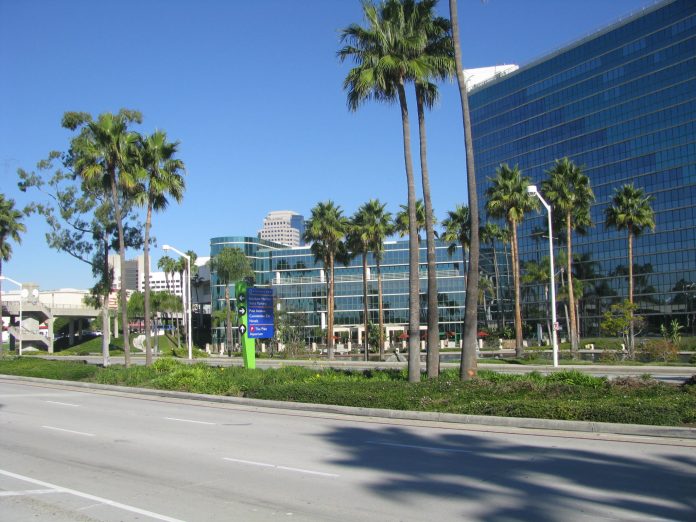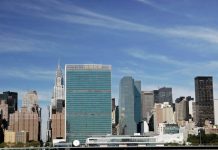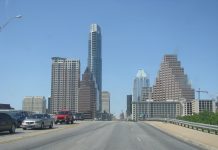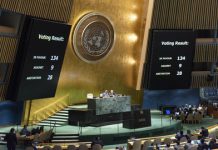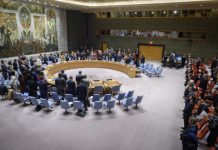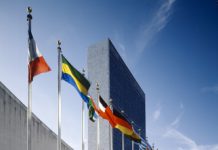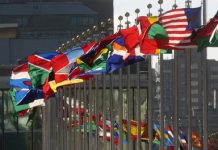Photo credit: DiasporaEngager (www.DiasporaEngager.com).
By Hanna Love and Hannah Stephens, The Brookings Institution —
Cities nationwide are facing a dual challenge when it comes to public safety. The place-based assets proven to keep communities safe—including employment, housing, and education—are under threat at the same time that punitive measures shown to exacerbate crime, recidivism, and taxpayer costs are being championed.
Take the case of Washington, D.C. On March 28, President Donald Trump issued an executive order titled Making the District of Columbia Safe and Beautiful, which mandates new punitive enforcement and federal oversight measures in Washington, D.C. and represents an escalation of his years-long fixation on crime in the nation’s capital.
The order urges the District’s police force—which is already the largest per capita of any city in the nation—to increase enforcement of “quality of life” crimes, maximize deportation efforts, and occupy public spaces such as transit centers and public parks at higher rates. It also eases gun restrictions for District residents, increases pretrial incarceration, and tasks the National Park Service to remove homeless encampments without directives on supporting rehousing efforts for those they displace.
The order comes at a time when the socioeconomic fabric of Washington, D.C. is already under threat. For example, in the District, federal employment is projected to decline by 21% (40,000 jobs) in the next six months, leaving many families uncertain of their financial future. Congress’ recent failure to pass the bipartisan District of Columbia Local Funds Act could trigger $1 billion in funding cuts to youth programming, education, and emergency response in the city if lawmakers don’t act when they return to session this week. Additionally, Washington, D.C.’s Home Rule—which authorizes democratically elected municipal leaders to make decisions on policing and other city-level policies—is undergoing continued threats from Congress, which risks limiting democratic participation in the majority-Black and Latino or Hispanic city.
While these challenges are immediately acute for the District, they are by no means confined to the nation’s capital. Communities nationwide are reckoning with similar cuts to critical services, expansion of “tough-on-crime” policies, and efforts to assert centralized control over policing in majority-minority places. In this piece, we present the evidence on why policies such as those proposed in Trump’s executive order risk worsening community safety and well-being. We first offer a summary of policies proven to foster “safe and beautiful” communities without exacerbating harm to people, places, and local economies, and conclude with guidance on how policymakers can advance community safety in an environment of significant federal uncertainty by leading with evidence.
Crime trends in Washington, DC and cities nationwide
Even though recent political rhetoric paints Washington, D.C. as ridden with crime and disorder, the city is actually the safest it’s been in over 30 years. In 2024, for instance, violent crime declined by 35%, while youth arrests and other forms of crime such as carjackings and robberies also significantly decreased.
Washington, D.C.’s progress on crime reduction mirrors national trends, as crime has fallen dramatically nationwide since 2023, and murder rates are now at or below pre-pandemic levels. Recent Brookings research attributes this success to the return of jobs and educational opportunities for people after the COVID-19 pandemic—not changes to policing, sentencing, or other criminal justice practices.
While perceptions of crime undoubtedly remain a concern for some, research indicates that such perceptions can be tied to racial stereotypes, particularly those held against Black Americans and, most recently, Latin American immigrants—even though evidence shows that neither group disproportionately contributes to crime.
Even with recent crime reductions in the District and across the nation, Trump’s executive order calls for doubling down on punitive approaches to address the city’s “nightmare of murder and crime,” while threatening the critical public services and employment opportunities that keep its residents safe. Without immediate, coordinated action to restore fiscal health and uplift evidence-based safety approaches, these actions risk catalyzing a significant increase in crime both within the District and the nation writ large.
The evidence: What does and does not work to keep cities safe
By following the evidence, local and state leaders in the District and across the nation can improve public safety outcomes without the significant human and economic costs derived from overly punitive approaches. To aid in this imperative, we present evidence on both what does and doesn’t work to reduce crime in cities nationwide.
Avoiding what doesn’t work
Many of the actions embedded in Trump’s executive order have been proven to make crime worse. Decades of evidence show that overly punitive enforcement of low-level “quality-of-life” offenses such as loitering and vagrancy—which the order explicitly calls for—can negatively impact crime and other well-being outcomes. Even short periods of incarcerationmake people more likely to commit future crimes, increase racial disparities, and produce negative effects on lifelong labor force participation and statewide labor market outcomes. The negative ramifications are particularly stark for youth, and the District’s Department of Youth Rehabilitation Services is already facing legal action over its harsh treatment of incarcerated young people, including for a lack of rehabilitation and mental health treatment.
Punitive approaches to homelessness—such as the tent encampment clearings proposed in the executive order and also unfolding in cities nationwide—risk worsening safety outcomes for similar reasons. Jailing unhoused people increases their likelihood of future arrests, while the cycle between homelessness, shelter, and incarceration is estimated to annually cost taxpayers $83,000 per individual—well above the costs of providing treatment and housing. Moreover, the recent dismantling of the United States Interagency Council on Homelessness (which manages federal homelessness assistance to states and localities) risks diminishing support for evidence-based, housing-first models while leaving criminalization as one of the few options left to manage unhoused populations.
Finally, the Trump administration’s efforts to assert federal control over local policing in Washington, D.C. could worsen police-community relations, as could its ongoing efforts to threaten the District’s Home Rule. Similar pushes to deputize local law enforcement for national immigration purposes are straining police-community dynamics in states from Florida to Mississippi to Montana. These actions, combined with other state-level reforms designed to assert state executive branch authority over local policing in majority-Black cities such as Jackson, Miss. have led to lawsuits alleging racial discrimination and unconstitutional overreach. Taken together, approaches that impose federal and state control over local policing policies—whether for increased deportation efforts or general police presence—are the antithesis of an evidence-based approach and risk significant negative consequences to community and fiscal well-being.
Embracing—and protecting—what does work
Fortunately, there is strong evidence showing what does keep communities safe—the bulk of which points to investing in the “social determinants of safety” such as education, neighborhood vitality, and economic stability, which public opinion also supports. Unfortunately, many of these evidence-based approaches are at risk not only in Washington, D.C. but nationwide, due to significant cuts to public health programming, federal employment opportunities, and other critical housing and community development initiatives.
To aid public officials in retaining the supports needed to truly foster “safe and beautiful” communities, this section presents five evidence-based actions that improve public safety but are at significant risk in the current administration.
- Youth development and education: Investment in youth is one of the most impactful ways policymakers can support long-term community safety, including through early childhood programs, mental health treatment, summer jobs, education, and after-school programs.Worryingly, however, local schools and other youth-serving recreation centers in Washington, D.C. are facing millions of dollars in cuts if the Congress does not pass the District of Columbia Local Funds Act upon returning to session. Moreover, states and localities nationwide are facing significant federal cuts to their education spending, causing many to cancel critical services for students and school upgrades.
- Access to employment and economic stability: Access to stable employment is a strong predictor of public safety, particularly among young people. So too are efforts to bolster workforce development and ensure financial stability through cash-assistance programs.Unfortunately, recent cuts to the federal workforce could cause the District’s unemployment rate to reach 10%, while reverberating employment losses could reach into the tens of thousands for communities in every corner of the nation. State and local leaders nationwide are being forced to respond by raising taxes to fund essential government services, reducing unemployment benefits, and gutting federally funded services for small business development. These widespread losses in employment, income, and spending power risk worsening crime outcomes, particularly for people living in neighborhoods of concentrated poverty.
- Housing and community development: Increasing access to housing and homeownership is shown to improve community safety. Providing permanent housing subsidies and increasing the supply of housing in local markets have been shown to reduce violent crime, as do programs such as the Low-Income Housing Tax Credit. Other community development investments such as reducing neighborhood foreclosures and vacancies are powerful crime-fighting tools.Yet housing and community development investments are also at risk from recent federal actions in both the District and nationwide. These actions have targeted the Community Development Financial Institutions Fund; reduced capacity and programming at the Department of Housing and Urban Development; laid off 40% of employees at the Federal Housing Administration; and terminated Special Purpose Credit Programs designed to close racial gaps in home and business ownership. These actions have significant potential to increase foreclosures, vacancies, and housing insecurity in nearly every congressional district nationwide—thus risking community safety progress in the process.
- Health care and preventative public health interventions: Increasing access to health care, substance use treatment, and mental health treatment is significantly associated with reductions in crime and recidivism. For example, states that expanded Medicaid coverage under the Affordable Care Act saw significant decreases in annual crime ratesand an annual cost savings of $13 billion. At the community level, neighborhoods that increased substance use treatment facilities in a geographic area also saw a reduction in violent and financially motivated crimes in the same area. Public-health-based community violence intervention programs have also shown promising results, but are now facing funding uncertainty and cuts.Particularly concerning is that federal funding for social assistance programs such as Medicaid is facing significant cuts, putting up to 5 million adults nationwide at risk of cancelled health care coverage. In the District specifically, proposed cuts threaten the loss of $58 million in funding for community health centers. Moreover, the Trump administration has already cancelled about $12 billion in public health funding, causing many Substance Abuse and Mental Health Services Administration-funded state health agencies to begin laying off staff at the same time that recent federal cuts have paused the functioning of the mental health crisis line (988) in states across the nation.
- Access to food and nutrition: Another key pathway to public safety is to address food insecurity and expand access to nutrition, including through the Supplemental Nutrition Assistance Program (SNAP), school lunch programs, and nutrition programs for newborns. In fact, studies on the timing on SNAP benefits indicate that not having access to these benefits increases nonviolent quality-of-life crimes such as theft.Concerningly, Republican lawmakers in the House of Representatives are calling for at least $230 billion in cuts from Agriculture Committee programs, which would require states to pay a portion of their SNAP costs. If successful, this proposal would leave an estimated 140,000 District residents without access to adequate food or nutrition, which could engender significant public safety and well-being consequences.
In short, there is strong evidence showing what works to keep communities safe and thriving. As recent federal actions threaten the viability of these strategies within and beyond the nation’s capital, it is critical that policymakers protect and preserve the initiatives that are already showing promise. There is no viable path to community safety when residents have greater access to law enforcement than they do basic necessities such as food and clean drinking water.
How to truly foster ‘safe and beautiful’ communities within and beyond the nation’s capital
As a first step, securing Washington, D.C.’s budget through the District of Columbia Local Funds Act is crucial to the city’s ability to remain “safe and beautiful,” as it supports critical services proven to reduce crime. According to Mayor Muriel Bowser’s office, failure to pass the act would require the District to revert to the last year’s budget level—cutting $350 million from public and charter school budgets, $67 million from the Metropolitan Police Department, $42 million from the Fire and EMS Department, and $28 million from the Department of Human Services. Additionally, the cuts to federal jobs could lower the median income of District residents and therefore generate lower tax revenues to support social assistance programs for low-income and elderly households, meaning the impacts will likely fall hardest on the most vulnerable residents.
Beyond functional budgets, building safe and beautiful communities requires investing in the people of those communities, not locking them up. Cities eager to reduce crime should follow the evidence: that crime is proven to be a preventable symptom, cured by secure access to education, good jobs, health care, food, and housing. A community that truly thrives needs schools and youth programs that are funded and reach all communities, regardless of income. Programs such as SNAP and Medicaid should be expanded, not reduced. Good government jobs should be protected and uplifted as ways of building the middle class. And access to housing should be made available to all through rental assistance and Special Purpose Credit Programs to increase homeownership.
To keep communities safe, policymakers must invest in these economic, social, and built environment assets that support community prosperity, inclusion, and well-being, rather than doubling down on punitive approaches that can make safety and fiscal well-being even worse.
Source: The Brookings Institution
Acknowledgements and disclosures: The authors would like to sincerely thank Thea Sebastian and Andre Perry for their contributions and reviews of various drafts of the piece.
Featured image: Washington, DC Metro Police Ford Police Interceptor (Wikimedia Commons)
Source of original article: The Institute of the Black World 21st Century (ibw21.org).
The content of this article does not necessarily reflect the views or opinion of Global Diaspora News (www.GlobalDiasporaNews.com).
To submit your press release: (https://www.GlobalDiasporaNews.com/pr).
To advertise on Global Diaspora News: (www.GlobalDiasporaNews.com/ads).
Sign up to Global Diaspora News newsletter (https://www.GlobalDiasporaNews.com/newsletter/) to start receiving updates and opportunities directly in your email inbox for free.


